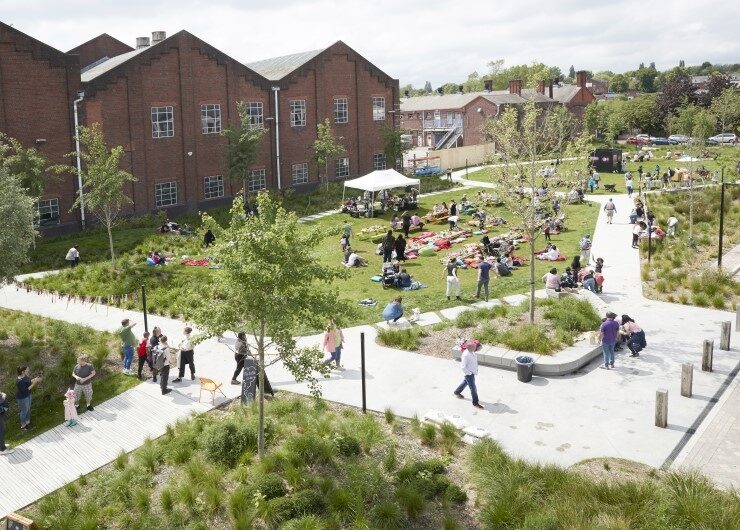Dr Simon J. Marshall
August 14th, 1970 – June 1st, 2024

A tribute by Stuart Biddle and Mark Falcous
Stuart was Simon’s PhD supervisor at Loughborough University. Mark was a fellow PhD student with Simon and struck up a great friendship that lasted for the rest of Simon’s life.
Simon Marshall died of pancreatic cancer on June 1st, 2024. He was just 53 years of age. It was a tragic loss for all who knew him.
Simon was so talented that he had several highly successful careers. After spending his childhood in Loughborough, Leicestershire, UK, he studied for his undergraduate degree in sports science at Liverpool John Moores University, a world-leading department for his subject. He graduated with a 1st Class Honours, the highest category in the UK system. His passion at the time was sport psychology and he travelled to San Diego State University to undertake a MSc degree in the subject. While there, he developed an interest in wider aspects of physical activity for health and secured employment as a research assistant in projects led by Drs James Sallis and Thom McKenzie, iconic leaders in the field. Publications from his work there included:
- McKenzie, T. L., Marshall, S. J., Sallis, J. F., & Conway, T. L. (2000). Student activity levels, lesson context, and teacher behavior during middle school physical education. Research Quarterly for Exercise and Sport, 71, 249-259.
- McKenzie, T. L., Marshall, S. J., Sallis, J. F., & Conway, T. L. (2000). Leisure-time physical activity in school environments: An observational study using SOPLAY. Preventive Medicine, 30, 70-77.
- Sallis, J. F., Conway, T. L., Prochaska, J. J., McKenzie, T. L., Marshall, S. J., & Brown, M. (2001). The association of school environments with youth physical activity. American Journal of Public Health, 91, 41-43.
Stuart: In 1998, I started a new job as Professor at Loughborough University in what is now the School of Sport, Exercise & Health Sciences. As part of my start-up funds, I had a PhD scholarship to offer. I emailed a number of my contacts, including Jim Sallis and Thom McKenzie. They informed me that a British researcher of theirs was interested. It was Simon.
Soon into his time at Loughborough we were discussing possible directions for his work. Simon mentioned that he thought ‘sedentary Behavior’ was going to be an important trend. Although another PhD student of mine, Andy Smith, had mentioned in his research that it might be important to distinguish between sedentary and active Behaviors, we didn’t take it too far. I was impressed with the initial conversation with Simon and asked him to write something and let me consider it further. A little later, he presented me with a discussion paper and research proposal that was hugely impressive. My immediate reaction was ‘wow, this is fundable research’, and he hadn’t really started his PhD yet!
I worked on the paper with Simon and submitted it to the British Heart Foundation. We received a grant of £111,000 in 2000, and additional smaller funding from the Health Education Board for Scotland. This created ‘Project STIL’ (Sedentary Teenagers and Inactive Lifestyles). Not only did we have a funded project, but it provided the foundation for Simon’s PhD at Loughborough “From runner bean to couch potato: Youth, inactivity and health” (2001). As we were on the cusp of paper-based and e-based data collection methods at that time, and our funding was small, Simon suggested we adopt a paper-based ecological momentary assessment diary to collect Behavioral data, including sedentary Behaviors. Despite the volume of work, including manual data entry, we accumulated a highly valuable data set that included over 1,500 adolescents and their reporting of real-time Behavior every 15 minutes in their leisure time over 4 days! We produced more than 40 publications based on Project STIL. Key papers included:
- Marshall, S. J., Biddle, S. J. H., Gorely, T., Cameron, N., & Murdey, I. (2004). Relationships between media use, body fatness and physical activity in children and youth: A meta-analysis. International Journal of Obesity, 28, 1238-1246. [This is Simon’s most highly cited paper with 827 citations in Scopus as of September 2024].
- Gorely, T., Marshall, S. J., & Biddle, S. J. H. (2004). Couch kids: Correlates of television viewing among youth. International Journal of Behavioral Medicine, 11, 152-163.
- Marshall, S. J., Gorely, T., & Biddle, S. J. H. (2006). A descriptive epidemiology of screen-based media use in youth: A review and critique. Journal of Adolescence, 29, 333-349.
- Gorely, T., Marshall, S. J., Biddle, S. J. H., & Cameron, N. (2007). Patterns of sedentary Behavior and physical activity among adolescents in the United Kingdom: Project STIL. Journal of Behavioral Medicine, 30, 521-531.
- Biddle, S. J. H., Gorely, T., & Marshall, S. J. (2009). Is television viewing a suitable marker of sedentary behavior in young people? Annals of Behavioral Medicine, 38, 147-153.
I was able to employ Simon as a post-doctoral researcher immediately after he finished his PhD, and this enabled further data collection and analysis as well as writing up. But, after one year, Simon received a job offer at San Diego State University. He, and his new wife, Lesley (a student of English and Drama at Loughborough), set off for the next stage of their careers. I consider myself privileged to have supervised Simon for his PhD and post-doc work.
Simon carved out a highly successful academic career at SDSU and latterly, University of California, San Diego. But he was funded primarily through grants, and this took its toll. He once said he worked 10% on 10 projects, and that proved unsustainable.
Simon was a first-class communicator. Not only was he engaging and funny, but he also communicated complex ideas very well. His keynote lecture at the 2013 International Society for Behavioral Nutrition and Physical Activity (ISBNPA) Conference in Ghent, Belgium, in a wondrously ornate hall, was a masterpiece.
His productivity was always high, and papers around the time he was working in San Diego included his continuing interest in sedentary Behavior:
- Bryant, M. J., Lucove, J. C., Evenson, K. R., & Marshall, S. (2007). Measurement of television viewing in children and adolescents: A systematic review. Obesity Reviews, 8, 197-209.
- Salmon, J., Tremblay, M. S., Marshall, S. J., & Hume, C. (2011). Health risks, correlates, and interventions to reduce sedentary behavior in young people. American Journal of Preventive Medicine, 41, 197-206.
- Maniccia, D. M., Davison, K. K., Marshall, S. J., Manganello, J. A., & Dennison, B. A. (2011). A meta-analysis of interventions that target children’s screen time for reduction. Pediatrics, 128, e193-e210.
On walking:
- Kang, M., Marshall, S. J., Barreira, T. V., & Lee, J. O. (2009). Effect of pedometer-based physical activity interventions: a meta-analysis. Research Quarterly for Exercise & Sport, 80, 648-655.
- Marshall, S. J., Levy, S. S., Tudor-Locke, C. E., Kolkhorst, F. W., Wooten, K. M., Ji, M., Macera, C. A., & Ainsworth, B. E. (2009). Translating physical activity recommendations into a pedometer-based step goal: 3000 steps in 30 minutes. American Journal of Preventive Medicine, 36(5), 410-415.
And on measurement:
- Kelly, P., Marshall, S. J., Badland, H., Kerr, J., Oliver, M., Doherty, A. R., & Foster, C. (2013). An ethical framework for automated, wearable cameras in health behavior research. American Journal of Preventive Medicine, 44, 314-319.
- Ellis, K., Kerr, J., Godbole, S., Lanckriet, G., Wing, D., & Marshall, S. (2014). A random forest classifier for the prediction of energy expenditure and type of physical activity from wrist and hip accelerometers. Physiological Measurement, 35, 2191-2203.
- Atkin, A. J., Gorely, T., Clemes, S. A., Yates, T., Edwardson, C., Brage, S., Salmon, J., Marshall, S. J., & Biddle, S. J. H. (2012). Methods of measurement in epidemiology: sedentary Behavior. International Journal of Epidemiology, 41, 1460-1471.
Simon left academia and started a company with his wife. Lesley. Les was a highly successful triathlete who won the 2011, 2012 and 2018 XTERRA Triathlon World Championships as well as the 2012 and 2018 editions of the World Triathlon Cross Championships. Together they established a company, Braveheart Coaching, which offered “personalized training methods of World Champion triathlete Lesley Paterson with state-of-the-science mental training from her husband, Dr Simon Marshall, an expert in sports psychology” (www.braveheartcoach.com). Their book The Brave Athlete: Calm the F*ck Down and Rise to the Occasion is an engaging, intelligent, humorous and highly useful sport psychology book. One only has to watch some of the many interviews and podcasts that featured Simon talking about training, competing, and sport psychology to realise what a master communicator he was – this time not for an academic audience but for those wanting clear and helpful advice in a language that is at their level. His writing was equally engaging.
Building on her background in drama and theatre, Les was a screenwriter for the Oscar-winning film, ‘All Quiet On The Western Front’. Simon could also use his highly skilled and adaptable writing to screen plays and he was about to embark on a major film when he received his cancer diagnosis. I wrote to Simon in the January just after he was diagnosed with his cancer. His reply shows how well things were going prior to the tragic news:
“It’s been an unbelievably cruel ride following a year of the highest highs … but such is life. I’ve chosen to fight and will continue to do so until I am rid of this awful disease with its indiscriminate hands. Our Hollywood life is going gangbusters … far too much to explain over email.”
Simon achieved so much in a life cut so short. His academic achievements, his work in sport psychology as a consultant, his communication skills, and his writing skills across academia, applied sport science, and films, marks him out as a truly special talent.
Mark: I first met Simon at Loughborough University in 1999 where we were working on our PhDs in the same department, and we hit it off as friends instantly. We navigated our PhD journeys together, shared a small, terraced house, and enjoyed the shared passion of cycle racing. We both served on the University Students cycling club committee, racing for Loughborough during these years. We were both part of the 2000 national university championship winning track cycling team.
It was obvious with Simon from the outset that he was intelligent, hard-working, and humble with a great sense of humour and never undue gravitas. In the 20 years since the Loughborough days, he applied these qualities across the multiple, successful careers that he enjoyed. First in academia and then in coaching, and subsequently film. To listen to him being interviewed in various podcasts was to witness his masterful ability to convey complex ideas and themes in language that was accessible and engaging. A rare quality in those so versed in the breadth, complexity and jargon of research literatures.
The last time I saw Simon was in January 2024, when the cruelness of cancer had struck. To see his physical decline was heartbreaking. True to form he spoke intelligently and bravely about his situation. I even recall one treatment I went along with him to in a Santa Monica clinic that summed up his spirit. As he hopped up on the bed, the nurse manoeuvred the arm of the equipment into place above his pancreas for the treatment, he requested ‘medium rare please’. Even in the face of the cruel awfulness of cancer he was quick witted and funny and wanted to make people laugh.
I’d like to acknowledge Lesley’s immense strength as she gave heart and soul to him at this time and subsequently – an incredible force for Simon in the very toughest of circumstances that are imaginable. A word also on both Simon and Lesley’s extended families. The way you rallied around Simon as his health declined was remarkable, heartwarming, and impressive, amidst the trauma and pain of what was happening.
It’s fair to say Simon was the most impressive person I have ever met. An inspiring, smart academic, mentor, psychologist, writer, brother to Vic, son and son-in-law, rock solid husband to Lesley, friend; and loved by so many.
When I heard Simon had lost his battle, I e-mailed a former colleague of mine in New Zealand: A Māori researcher, Ihirangi Heke, who Simon had met at a conference in New Zealand over ten years previously. Simon had subsequently hosted him along with others at UC San Diego. Ihirangi recounted to me what a special person Simon was. Asked me to pass on respects to his wahine – his wife, Lesley. And noted how his roopu (group) who he had travelled with had been amazed at Simon’s generosity of hosting even total strangers. In the Maori culture, manaakitanga – generous hosting of others – is a high source of prestige. A Māori saying comes to mind that sums up Simon: he piko, he taniwha – at every turn, a mighty presence.
Simon’s memory, his legacy, his spirit will live on in all of us, and forever. We could all do a lot worse than tackle life with the intelligence, energy, charm, and wit that Simon did. He had plenty to be confident about; much more than most in fact. But he retained a low-ego, charm, and good humour despite his many and quite frankly staggering achievements across several walks of life. Life was more fulfilling, richer and special for all of us, for having Simon in it. A truly wonderful friend who will be missed every day.
Stuart Biddle, University of Southern Queensland, Australia
Mark Falcous, University of Otago, New Zealand




